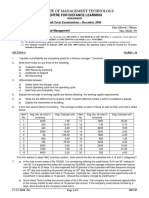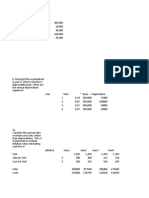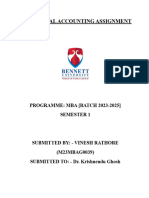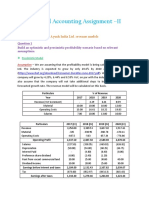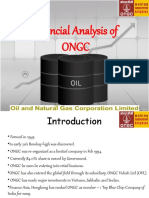Finance Question Paper
Finance Question Paper
Uploaded by
abhimani5472Copyright:
Available Formats
Finance Question Paper
Finance Question Paper
Uploaded by
abhimani5472Original Title
Copyright
Available Formats
Share this document
Did you find this document useful?
Is this content inappropriate?
Copyright:
Available Formats
Finance Question Paper
Finance Question Paper
Uploaded by
abhimani5472Copyright:
Available Formats
INSTITUTE OF MANAGEMENT TECHNOLOGY
CENTRE FOR DISTANCE LEARNING
GHAZIABAD
End-Term Examinations – June 2009
Subject Code : IMT-07 Time Allowed : 3 Hours
Subject Name: Working Capital Management Max. Marks : 50
Notes: (a) Answer any FOUR questions from SECTION-A and CASE STUDY as given in SECTION-B.
Each Question (SECTION-A) carries 9 MARKS and (SECTION-B) Case Study carries 14 MARKS.
(b) No doubts/clarifications shall be entertained. In case of doubts/clarifications, make reasonable assumptions and proceed.
(c) For students enrolled in January 2008, July 2008 and January 2009 batches, the Question Paper would be treated for
70 marks instead of 50 marks.
SECTION-A MARKS : 36
Q.1 ‘Efficient cash management will aim at maximizing the availability of cash inflows by decentralizing collections and
decelerating cash outflows by centralizing disbursements’. Discuss
Q.2 Discuss any three of the following:
a) Conservative approach of working capital finance
b) Impact of inflation of working capital management
c) JIT as a tool of inventory management
d) Commercial papers
Q.3 A firm has several items of inventory. The average number of each of these as well as their unit cost is listed below:
Item Avg. No. of units in Avg. Cost per unit Item No. Avg. No. of units in Avg. Cost per unit
No. inventory inventory
1 4000 1.96 11 1800 25.00
2 200 10.00 12 130 2.70
3 440 2.40 13 4400 9.50
4 2000 16.80 14 3200 2.60
5 20 165.00 15 1920 2.00
6 800 6.00 16 800 1.20
7 160 76.00 17 3400 2.20
8 3000 3.00 18 2400 10.00
9 1200 1.90 19 120 21.00
10 6000 0.50 20 320 4.00
The firm wishes to adopt ABC inventory system. How should the item be classified into A, B and C categories?
Q.4 Differentiate between:
a) Payment float and receivable float
b) Budgeting and forecasting
c) Buffer stock level and danger level
Q.5 A small firm has a total credit sales of Rs 80 lakhs and its average collection period is 80 days. The past experience
indicates that bad debt losses are around 1 percent of credit sales. The firm spends about Rs 120000 per annum on
administering its credit sales , this cost includes salaries of one officer and two clerks who handle credit checking &
collection . A factor is prepared to buy the firms receivables by charging 2 percent commission and interest at the rate of 18
percent after withholding 10 percent as reserve . What should the firm do ?
Q.6 What is credit control? What is the role of the credit control department?
Q.7 A Performa cost sheet provides the following particulars:
Particulars Amount per unit(Rs)
Elements of cost
Raw material 80
Direct Labour 30
Overhead 60
Total Cost 170
Profit 30
Selling Price 200
25-6-2009 (E) Page 1 of 2 IMT-07
The following further particulars are available:
Raw Material in stock, on average, one month; Material in process ( completion stage 50%), on average, half a month;
Finished goods in stock, on average , one month.
Credit allowed by suppliers is one month; credit allowed to debtors is two months; average time lag in payment of wages is
1.5 weeks and one month in overhead expenses; one fourth of the output is sold against cash; cash in hand & cash at bank
to be maintained at Rs 3,65,000.
You are required to prepare a statement showing the working capital needed to finance a level of activity of 1,04,000 units
of production. You may assume that production is carried on evenly through out the year , and wages and overheads
accrue similarly. For calculation purpose , 4 weeks may be taken as equivalent to a month.
SECTION-B (Case Study) MARKS : 14
Bose Engineering has had a very poor bad debt record and, for this reason it has devised the method of credit control based on
analyses of its debt experience and of the personal characteristics of its customers. It is ascertained its good and bad debt
experiences from a sample of actual orders executed. It ranked its customers using a points system from 0 to 100 , where 0
denoted a class of customers with the highest percentage of bad debts and 100 denoted a class with the highest percentage of
good debts. These analysis led to the preparation of following tables:
Point Ratings Cumulative total no. of Cumulative no. of orders received Cumulative no. of orders received
orders received which turn out to be good debts which turn out to be bad debts
0-10 1150 200 950
0-20 2100 450 1650
0-30 2850 750 2100
0-40 3950 1500 2450
0-50 6600 4000 2600
0-60 8150 5400 2750
0-70 9100 6250 2850
0-80 9500 6600 2900
0-90 9750 6800 2950
0-100 10000 7000 3000
The table shows, cumulatively , an analysis of the customers by class and an analysis of good & bad debts within each class per
10,000 orders received.
During 2005, the company rejected all orders from customers with a credit rating of 50 and below with the result that a sample
profit and loss account, based on the table of 10,000 orders received, appeared as follows:
Sales ( 3400 orders @ Rs 14/- per order) 47600
Variable Costs:
Purchases 3400 @ Rs 3/- 10200
Distribution 3400 @ Rs 2/- 6800 17000
30600
Overheads:
Administration & Selling Expenses 18200
Bad Debts @ Rs14/- 5600 23800
6800
Assume that administration and selling expenses remaining constant
a) Apply the 2005 prices and costs to the statistical table to show cumulatively for the first five classes of customers the effect
on profits of declining to accept orders in each class. Present your answer in columnar form in terms of contributions to
overheads and profit lost, costs saved and the total gain or loss.
b) Prepare a sample profit and loss account , similar to that shown and based on 10000 orders received, assuming that all
orders from customers with a credit rating of 20 and below are rejected.
25-6-2009 (E) Page 2 of 2 IMT-07
You might also like
- On The Existence of Digital Objects Yuk Hui 45 731Document33 pagesOn The Existence of Digital Objects Yuk Hui 45 731Raluca MariaNo ratings yet
- Help Desk Technical Design DocumentDocument13 pagesHelp Desk Technical Design DocumentVenkat RamavathNo ratings yet
- Luck Be A Lady SinatraDocument5 pagesLuck Be A Lady Sinatra-SCI- Soup75% (4)
- Sample Exam Paper With Answers PDFDocument6 pagesSample Exam Paper With Answers PDFabhimani5472100% (1)
- Seminar Report On M-Commerce & Its Security IssuesDocument40 pagesSeminar Report On M-Commerce & Its Security IssuesSameer Yadav100% (1)
- Test Bank For Organic Chemistry 7th Edition by BrownDocument23 pagesTest Bank For Organic Chemistry 7th Edition by Brownandielana100% (1)
- Ipm Question SDocument7 pagesIpm Question SAamir AwanNo ratings yet
- Institute of Management Technology: Centre For Distance LearningDocument2 pagesInstitute of Management Technology: Centre For Distance Learningabhimani5472No ratings yet
- AGMGT - Merge File 6,7,8Document15 pagesAGMGT - Merge File 6,7,8Marg'riette PascuaNo ratings yet
- 2015 Bba305 PomDocument1 page2015 Bba305 PomTanishq MoghaNo ratings yet
- FBF Final Project Report (Financial Plan)Document6 pagesFBF Final Project Report (Financial Plan)Afaq BhuttaNo ratings yet
- Assignment #2 FABMDocument5 pagesAssignment #2 FABMIce Voltaire B. Guiang100% (1)
- Paper 3 Cost Accounting and Financial ManagementDocument5 pagesPaper 3 Cost Accounting and Financial Managementmt93570No ratings yet
- Cost Accounting and FM IpcoDocument18 pagesCost Accounting and FM Ipcomayoogha1407No ratings yet
- Facgdse07T-B.C - (DSE2) : West Bengal State UniversityDocument3 pagesFacgdse07T-B.C - (DSE2) : West Bengal State UniversityurqjaaucqxNo ratings yet
- Enter PPTTTTDocument15 pagesEnter PPTTTTeyob hailuNo ratings yet
- CMA SS August 2018Document12 pagesCMA SS August 2018Goremushandu MungarevaniNo ratings yet
- long-run-average-costsDocument4 pageslong-run-average-costsluca.cohendumaniNo ratings yet
- 03142022Econ101 政府角色 1Document52 pages03142022Econ101 政府角色 1hungshi88No ratings yet
- Srinath SirDocument19 pagesSrinath Sirmy Vinay100% (1)
- Financial ManagementDocument20 pagesFinancial ManagementClifford OmondiNo ratings yet
- SafariDocument49 pagesSafariwafaNo ratings yet
- ABC Analysis Practice Problems Nov 2016Document12 pagesABC Analysis Practice Problems Nov 2016manoj kumarNo ratings yet
- Basic Three-Sided Market ModelDocument6 pagesBasic Three-Sided Market Modelisaiah8195No ratings yet
- Lab 2Document3 pagesLab 2Talha Nasir0% (1)
- Statistics Practice WorkbookDocument87 pagesStatistics Practice Workbookaastha032004No ratings yet
- Financial Statement AnalysisDocument24 pagesFinancial Statement AnalysisMadhuram SharmaNo ratings yet
- Answer Tutorial 5Document4 pagesAnswer Tutorial 5Buaya PutihNo ratings yet
- Sri Balaji University Pune (Sbup) Bitm SEMESTER-I-BATCH - 2020-22 Management Accounting - Assignment - V (UNIT-V)Document9 pagesSri Balaji University Pune (Sbup) Bitm SEMESTER-I-BATCH - 2020-22 Management Accounting - Assignment - V (UNIT-V)Jaya BharneNo ratings yet
- Sr. No. Accounting Description Debit CreditDocument8 pagesSr. No. Accounting Description Debit CreditPratyuosh SrivastavNo ratings yet
- Cost DJB - July21 Suggested AnswersDocument30 pagesCost DJB - July21 Suggested AnswersMayuri KolheNo ratings yet
- Corporate Finance Practice Question 3Document2 pagesCorporate Finance Practice Question 3Abdullah IftikharNo ratings yet
- Aggregate Demand and Its ComponentsDocument7 pagesAggregate Demand and Its Componentssairamsrinivasan36No ratings yet
- Chap 11 Mini CaseDocument5 pagesChap 11 Mini CaseSaadNo ratings yet
- Costing MTP g1Document198 pagesCosting MTP g1Jattu TatiNo ratings yet
- ANANDAM CaseStudyDocument10 pagesANANDAM CaseStudyVineshNo ratings yet
- 0497427936124Document18 pages0497427936124Saleh AlgdaryNo ratings yet
- LDP 609-Revision Questions. Statistics PDFDocument27 pagesLDP 609-Revision Questions. Statistics PDFKen MugambiNo ratings yet
- Ge02 Model Question - Cma June 2018 - PacademiaDocument6 pagesGe02 Model Question - Cma June 2018 - PacademiaSumon Kumar DasNo ratings yet
- Financial Accounting Assignment - II: Ayush India Ltd. Revenue ModelsDocument7 pagesFinancial Accounting Assignment - II: Ayush India Ltd. Revenue ModelsnikunjNo ratings yet
- Revision Questions. StatisticsDocument27 pagesRevision Questions. StatisticsKen Mugambi100% (5)
- FM PracDocument15 pagesFM Pracanushkas0701No ratings yet
- Simsr2 Mba B III FM Quep 1Document4 pagesSimsr2 Mba B III FM Quep 1Priyanka ReddyNo ratings yet
- ONGC Financial AnalysisDocument20 pagesONGC Financial AnalysisJobin Jose KadavilNo ratings yet
- Guideline ICE1 TextOnlyDocument4 pagesGuideline ICE1 TextOnlyRima AkidNo ratings yet
- Q1Document31 pagesQ1Bhaskkar SinhaNo ratings yet
- PE6 SolutionsDocument14 pagesPE6 Solutionsalexiamorel21No ratings yet
- Assignment 02 2020 Memo MGA40ATDocument6 pagesAssignment 02 2020 Memo MGA40ATkmaapola97No ratings yet
- FM - Assignment 1 - F & MDocument4 pagesFM - Assignment 1 - F & MKrish KadyanNo ratings yet
- Production and Costs Case Mostafa ElbakryDocument2 pagesProduction and Costs Case Mostafa ElbakryMostafa El BakryNo ratings yet
- Cmie Word FileDocument11 pagesCmie Word FileAniruddha ChakrabortyNo ratings yet
- CAPITAL STRUCTURE Sums OnlinePGDMDocument6 pagesCAPITAL STRUCTURE Sums OnlinePGDMSoumendra RoyNo ratings yet
- DOW Exam Practise DEC 28 2020Document4 pagesDOW Exam Practise DEC 28 2020Hira SialNo ratings yet
- Mba 104 PDFDocument2 pagesMba 104 PDFSimanta KalitaNo ratings yet
- Business Simulation Team-HDocument12 pagesBusiness Simulation Team-Hpawan vermaNo ratings yet
- EcosystemDocument3 pagesEcosystemdarwin manaogNo ratings yet
- Business Analytics question setDocument3 pagesBusiness Analytics question setvalechany9113No ratings yet
- Taller Producción y CostosDocument1 pageTaller Producción y CostosSebastian valenciaNo ratings yet
- 2021 - Topic Specific Assignment 4 - Inventory - Module 9Document6 pages2021 - Topic Specific Assignment 4 - Inventory - Module 9Tham NguyenNo ratings yet
- Base Case Analysis Best CaseDocument6 pagesBase Case Analysis Best CaseMaphee CastellNo ratings yet
- ECO 550 WK 4 Chapter 7 and Chapter 8 Problems 766330745Document9 pagesECO 550 WK 4 Chapter 7 and Chapter 8 Problems 766330745Nek ManNo ratings yet
- Airtel Case STUDYDocument5 pagesAirtel Case STUDYSrutiNo ratings yet
- Book Method (Matrix) : Calculating IRRDocument9 pagesBook Method (Matrix) : Calculating IRRAli SaeedNo ratings yet
- Financials Template WITH EXAMPLESDocument44 pagesFinancials Template WITH EXAMPLESCẩm TiênNo ratings yet
- A Comparative Analysis of Tax Administration in Asia and the Pacific-Seventh EditionFrom EverandA Comparative Analysis of Tax Administration in Asia and the Pacific-Seventh EditionNo ratings yet
- A Comparative Analysis of Tax Administration in Asia and the Pacific: 2020 EditionFrom EverandA Comparative Analysis of Tax Administration in Asia and the Pacific: 2020 EditionNo ratings yet
- We Create Stock Market ProfessionalsDocument12 pagesWe Create Stock Market Professionalsabhimani5472No ratings yet
- Sample 168 PDFDocument26 pagesSample 168 PDFabhimani5472No ratings yet
- Delisting Candidates111Document6 pagesDelisting Candidates111abhimani5472No ratings yet
- Accredited Finance For Non-Financial Managers: Chartered Management Institute'S SyllabusDocument2 pagesAccredited Finance For Non-Financial Managers: Chartered Management Institute'S Syllabusabhimani5472No ratings yet
- Topic: Finance For Non Finance Executives FACULTY: Mr. J N MamtoraDocument3 pagesTopic: Finance For Non Finance Executives FACULTY: Mr. J N Mamtoraabhimani5472No ratings yet
- Finance For Non-Finance Managers: SCDL: Obj Ect IveDocument5 pagesFinance For Non-Finance Managers: SCDL: Obj Ect Iveabhimani5472No ratings yet
- Finance - For Non-Finance - ExecutivesDocument4 pagesFinance - For Non-Finance - Executivesabhimani5472No ratings yet
- Finance For Non-Finance Personnel 2011Document4 pagesFinance For Non-Finance Personnel 2011abhimani5472No ratings yet
- Institute of Management Technology: Centre For Distance LearningDocument2 pagesInstitute of Management Technology: Centre For Distance Learningabhimani5472No ratings yet
- Institute of Management Technology: Centre For Distance LearningDocument1 pageInstitute of Management Technology: Centre For Distance Learningabhimani5472No ratings yet
- Ininstitute of Management Technology: Centre For Distance LearningDocument2 pagesIninstitute of Management Technology: Centre For Distance Learningabhimani5472No ratings yet
- Institute of Management Technology: Centre For Distance LearningDocument2 pagesInstitute of Management Technology: Centre For Distance Learningabhimani5472No ratings yet
- Institute of Management Technology: Centre For Distance LearningDocument1 pageInstitute of Management Technology: Centre For Distance Learningabhimani5472No ratings yet
- Financial Planning - Dec 09Document2 pagesFinancial Planning - Dec 09abhimani5472No ratings yet
- International Finance - Dec 09Document1 pageInternational Finance - Dec 09abhimani5472No ratings yet
- Institute of Management Technology: Centre For Distance LearningDocument1 pageInstitute of Management Technology: Centre For Distance Learningabhimani5472No ratings yet
- Corporate Finance Practice QuestionsDocument11 pagesCorporate Finance Practice Questionsabhimani5472No ratings yet
- Welding SafetyDocument17 pagesWelding SafetySETIAJI WIBAWANo ratings yet
- 04 Crisologo V SingsonDocument6 pages04 Crisologo V SingsonKevin Ken Sison GancheroNo ratings yet
- International Standard of OccupationsDocument11 pagesInternational Standard of OccupationsNazmus Sakib KhanNo ratings yet
- Hager Company Profile - NewDocument31 pagesHager Company Profile - NewTrung Đỗ NguyễnNo ratings yet
- Burn ProtocolDocument2 pagesBurn ProtocolAli AftabNo ratings yet
- HP Fabric - Com Cleo Pyramid WrisletDocument10 pagesHP Fabric - Com Cleo Pyramid WrisletStar GazerNo ratings yet
- Self-Learning Modules Inventory Report As of - June 11, 2021 - Quarter First - Learing AreaDocument6 pagesSelf-Learning Modules Inventory Report As of - June 11, 2021 - Quarter First - Learing AreaShawn IsaacNo ratings yet
- Discrete Lecture - NotesDocument48 pagesDiscrete Lecture - NotesFiromsa MtNo ratings yet
- Operational Checks For STPDocument5 pagesOperational Checks For STPAshish A ArbaleNo ratings yet
- Socratic Seminar Secondary Lesson Plan Differentiation InTasc 2Document3 pagesSocratic Seminar Secondary Lesson Plan Differentiation InTasc 2stevendgreene85No ratings yet
- Module 3. Freedom of The Human PersonDocument14 pagesModule 3. Freedom of The Human PersonJojit VelascoNo ratings yet
- Security Threats To E-Commerce - Electronic Payment System - E-Cash - Credit-Debit CardsDocument3 pagesSecurity Threats To E-Commerce - Electronic Payment System - E-Cash - Credit-Debit CardsDev SharmaNo ratings yet
- CSS-LARF-Horticulture-Cookery-AP-Sample ContentDocument10 pagesCSS-LARF-Horticulture-Cookery-AP-Sample ContentLeah Mendrez CataposanNo ratings yet
- Nick Lacey Image and Representation p.6-51Document24 pagesNick Lacey Image and Representation p.6-51adela bravo100% (2)
- KênhDocument8 pagesKênhQuan LyNo ratings yet
- World Rabies Day: Working Together To Make Rabies History!Document7 pagesWorld Rabies Day: Working Together To Make Rabies History!Dr.Kedar Karki ,M.V.Sc.Preventive Vet.Medicine CLSU PhilippinesNo ratings yet
- manual gerber accumark gerber 16 newDocument23 pagesmanual gerber accumark gerber 16 newϻẸŇÃ. ČǗŤẸ.No ratings yet
- Child Care Services in Malaysia An OverviewDocument4 pagesChild Care Services in Malaysia An OverviewNur AzianNo ratings yet
- Difference Between Anthem and HymnDocument6 pagesDifference Between Anthem and HymnIng Jenny DavilaNo ratings yet
- Project Operational ManagementDocument21 pagesProject Operational ManagementZafar AliNo ratings yet
- AKD cpt03Document91 pagesAKD cpt03Anisha RosevitaNo ratings yet
- Relationship Between Pre-Service Teachers' Mathematics Self-Efficacy and Their Mathematics AchievementDocument14 pagesRelationship Between Pre-Service Teachers' Mathematics Self-Efficacy and Their Mathematics AchievementMuh YusufNo ratings yet
- People vs. Echaves G. R. No. L-47757-61 Aquino, J.: Lower Court Denied ItDocument12 pagesPeople vs. Echaves G. R. No. L-47757-61 Aquino, J.: Lower Court Denied ItsovxxxNo ratings yet
- Look at The Pictures. Circle The Correct Answer. A. Farm B. Arm Jam 1Document14 pagesLook at The Pictures. Circle The Correct Answer. A. Farm B. Arm Jam 1Sapura BasirNo ratings yet
- Canon 8.02Document1 pageCanon 8.02Vin LacsieNo ratings yet







